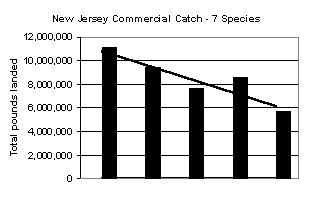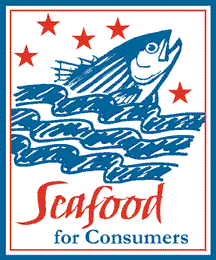
Number 8
July 24, 1999

 |
 |
Fisheries Management And Funding Conflicts
We’re from the government and we’re here to help you.
It wasn’t too many years ago when that’s all that people in the commercial fishing industry heard. The government was going to help them buy new boats. The government was going to help them catch more fish. The government was going to help them handle those fish better and sell them to more people for more money. The government even provided a multimillion dollar fund to pay for it all. From the National Marine Fisheries Service (NMFS) budget request for the year 2000 “The American Fisheries Promotion Act (AFPA) of 1980 authorized a grants program for fisheries research and development projects and a National Fisheries Research and Development Program to be carried out with Saltonstall-Kennedy (S-K) funds. S-K funds are derived from duties on imported fisheries products.”Or how about “we’re from the government and we’re here to help ourselves?”
[]
The United States imported more than $8 billion in seafood last year. So there should still be a big pot of money available to the National Fisheries Research and Development Program, and there are definitely research and development projects that could be done to help the industry. Somewhat puzzlingly - particularly when considering the NMFS description of the intent of Congress above - only 1.5 million S-K dollars (minus NMFS administrative costs, of course) will be available in industry grants for this coming year, and these grants are only to (again in the agency’s words - these from the Federal Register notice announcing the grant program): “1. eliminate and prevent overfishing and overcapitalization, 2. attain economic sustainability in fishing communities, and 3. develop environmentally and economically sound marine aquaculture.” Further in the Federal Register announcement NMFS elaborates on how these funds will be used to “attain economic sustainability.” Projects considered for funding will address “retraining of fishermen for alternative employment, alternative uses for existing fishing industry infrastructure, and planning for fishing capacity reduction.”
So, to “promote” commercial fishing, NMFS has decided to spend a miniscule part of the available S-K funds on projects further cutting back on harvesting and getting even more people, buildings and boats out of fishing. Some promotion.
What about the rest of the S-K revenues raised? Going back to the NMFS budget request, we see that “An amount equal to 30 percent of these duties is being transferred to the Department of Commerce from the Department of Agriculture (we don’t know what the USDA does with the remainder, about $150 million, but it surely isn’t going to helping fishermen). The FY 2000 Budget estimates this transfer at $66.4 million. Of this $66.4 million, $1.5 million will be used for the S-K grants program to develop a healthy fishery based industry (including costs of program administration). The remainder of the transfer ($64.9 million) will be used to offset the Operations, Research, and Facilities (ORF) account (of NMFS).” So we not only have the agency that is in charge of managing our nation’s fisheries “profiting” from its inability to manage those fisheries, we also have it using money intended by Congress to promote the industry being used instead to downsize the industry even more. And, of course, encouraging even more imports. Nice work if you can get it.Isn’t drastic downsizing of the fishing industry really necessary?
Most of us have read the various predictions of imminent or existing crises in fisheries around the world, including those in the United States’ being managed by NMFS and the regional councils. In view of these supposed widespread crises and in view of our evidently uncontrollable - at least in the estimation of the agency in charge - urge to keep on fishing, shouldn’t we be cutting back across the board on our ability to harvest? If one buys into the crisis pandering arguments of NMFS and the various anti-fishing groups, one would certainly think so. But let’s take a look at the stated goals of the NMFS’s National Recreational Fishery Resources Conservation Plan that is on that agency’s website []. Among them are: “Provide for increased recreational fishing opportunities nationwide through the conservation, restoration, and enhancement of aquatic systems and fish populations, and by increasing fishing access....Support and encourage programs and projects designed to enhance marine recreational fishing opportunities....encourage environmentally responsible acquisition and/or expansion of public access opportunities for anglers and boaters.”(emphasis added)
The NMFS leadership is committed to reducing the size of the commercial fishing industry - which at the same time will, happily for them, increase seafood imports and the amount of Saltonstall-Kennedy funds available to swell their budget - supposedly because of the sorry condition of the fisheries they manage. But at the same time they are committed to increasing and enhancing recreational fishing opportunities. And - again coincidentally? - by swelling recreational fishing and boating expenditures they will be increasing the Wallop-Breaux funds available to enhance recreational fishing and boating opportunities and access even more (see FishNet USA #4 for info on Wallop-BreauxSo what about recreational angling?).
But perhaps recreational fishermen and women don’t kill enough fish to make a difference. Or perhaps the commercial fishermen aren’t responding to the best efforts of the managers the way they should. Perhaps they really need to have their infrastructure yanked out from under them to get them to toe the management line. To see what’s going on we retrieved from the NMFS website the annual recreational catch []and commercial landings data [
] for the major inshore fish species (fluke, winter flounder, bluefish, scup, sea bass, striped bass - note that there is no commercial fishery for striped bass in New Jersey - and weakfish) for New Jersey for the years 1992 to 1996. They are graphed below. Assuming that the average weight of each of these fish caught by New Jersey anglers is a pound or two, and assuming that half the fish caught by recreational anglers are released and don’t subsequently die, for these most popular species the mortality due to recreational fishing in New Jersey is far higher than the commercial landings. And, most significantly, it’s been growing for the past five years while commercial landings have been dropping precipitously. From what we know of other states in the Mid-Atlantic and on south, we doubt it’s very different elsewhere. So why the total focus by NMFS on reducing commercial fishing effort?
 |
 |
Where is the increase in fishing mortality by recreational anglers coming from?
We’ve previously mentioned the seeming “immortality” of fiberglass, the nearly indestructible construction material of choice for virtually all recreational vessels built today. Going to the recreational boating/personal watercraft industry’s major trade group, the National Marine Manufacturers Association, we find that from 1997 to 1998 almost 600,000 boats were added to the U.S. recreational boating fleet. []. This is an annual growth rate of about 3%, which corresponds - coincidentally yet again? - to the average increase in the NJ inshore recreational angling catch for the last 4 years. Anyone familiar with the congestion of recreational tuna boats in the Mid-Atlantic’s offshore canyons knows the same growth is taking place there as well. And, without limits on the number of recreational boats or recreational fishing effort, there’s certainly no limit on what all these anglers collectively catch
The bottom line
It doesn’t take much insight to see that an increased number of boats, recreational or commercial, means an increased amount of fishing and a corresponding increase in the attendant levels of fishing mortality. So why is NMFS, the federal agency that is responsible for managing our nations fisheries and setting national fisheries policy, doing everything it can with one hand to reduce the size and the efficiency of the commercial fishing fleet while with the other it has embarked on an ambitious program to enhance and increase recreational fishing opportunities and access? Why has that agency been put in the position of increasing the size of its budget with every boat it removes from the commercial fishing fleet, every fish that it takes from the net of a commercial fisherman, and every dollar it adds to our trade deficit, and why has the fisheries management establishment been put in the position of increasing its budget with every fish landed by a recreational fisherman or woman and every boat bought by a recreational boater? How important are these apparent conflicts in molding the policies of NMFS, the regional Councils and the state fisheries agencies that depend on Saltonstall-Kennedy and Wallop-Breaux funding for large parts of their budgets? And most importantly, how believable can the dire warnings of commercial overfishing be when the agency that generates all the data they are based on applies them only to harvesting fish commercially and disregards them completely when it comes to its official policy of “increasing and enhancing” recreational fishing?Each year the National Marine Fisheries Service becomes more strident in its attempts to reduce the size of the commercial fishing industry and devotes more of its energies and resources to accomplishing that task. Each year the members of the commercial fishing industry have less faith in the agency and in a management system that, while attempting to drive them out of business, appears to be seriously conflicted and blatantly committed to allocation decisions based on inadequate science and what appears to be an inconsistent and unfair philosophy. Can the industry be blamed? And is the federal impetus to downsize the commercial fishing industry, which is now parroted by anti-commercial fishing groups hiding behind the “conservation” banner, really driven by biological necessity which for some reason doesn’t apply to recreational angling, or is it a predictable response to the self-serving interests of an agency with values severely distorted by these apparent conflicts?
|
|
| From a National Fish and wildlife Foundation release: “July 1, 1999 is the pre-proposal deadline for submitting matching grant proposals for the National Fish and Wildlife Foundation and Shell Oil Company Foundation program to fund projects that protect, conserve, or enhance the Gulf of Mexico ecosystem.” Then from CNN: “On July 6, 1999, about 4,500 fishermen and 500 shrimp vessels were reported to have established a blockade around a state-owned petroleum refinery at Ciudad del Carmen in the southern Gulf of Mexico, accusing the facility of damaging fisheries by pollution.” (From the CRS weekly fisheries update). Perhaps the fishermen should have applied for a Shell grant instead? |

![]()
| FishNet USA is distributed to over 1500 elected and appointed officials, media representatives, individuals and organizations with an interest in fisheries issues via fax and email. It is supported by Atlantic Capes Fisheries, the Fishermen’s Dock Cooperative, Lund’s Fisheries, Export, Inc., Agger Fish Corp., and Viking Village Dock |